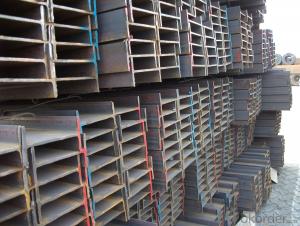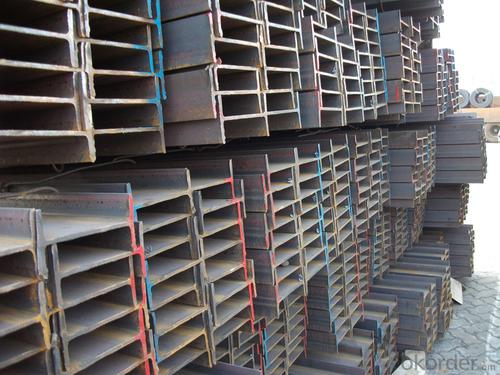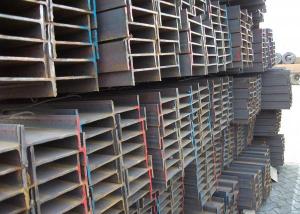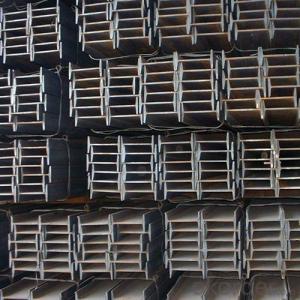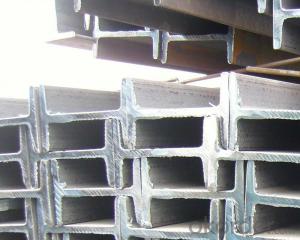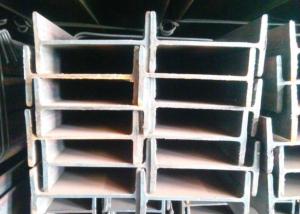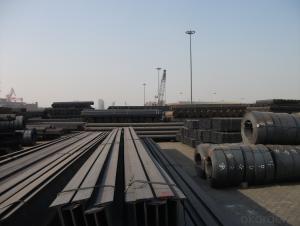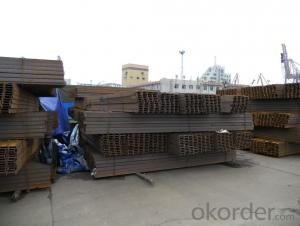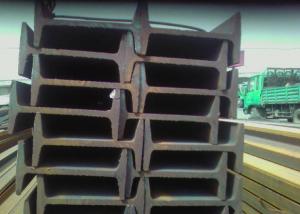IPE
- Loading Port:
- China Main Port
- Payment Terms:
- TT OR LC
- Min Order Qty:
- -
- Supply Capability:
- -
OKorder Service Pledge
OKorder Financial Service
You Might Also Like
Product Description:
Specifications of IPE Beam
1. Invoicing on theoretical weight or actual weight as customer request
2. Standard: EN10025, GB Standard, ASTM
3. Grade: Q235B, Q345B, SS400, ASTM A36, S235JR, S275JR
4. Length: 5.8M, 6M, 9M, 12M as following table
5. Sizes: 80mm-270mm
Dimensions(mm) | |||||
| h | b | s | t | Mass Kg/m |
IPE80 | 80 | 46 | 3.80 | 5.20 | 6.00 |
IPE100 | 100 | 55 | 4.10 | 5.70 | 8.10 |
IPE120 | 120 | 64 | 4.80 | 6.30 | 10.40 |
IPE140 | 140 | 73 | 4.70 | 6.90 | 12.90 |
IPE160 | 160 | 82 | 5.00 | 7.40 | 15.80 |
IPE180 | 180 | 91 | 5.30 | 8.00 | 18.80 |
IPE200 | 200 | 100 | 5.60 | 8.50 | 22.40 |
IPE220 | 220 | 110 | 5.90 | 9.20 | 26.20 |
IPE240 | 240 | 120 | 6.20 | 9.80 | 30.70 |
IPE270 | 270 | 135 | 6.60 | 10.20 | 36.10 |
Appications of IPE Beam
1. Supporting members, most commonly in the house raising industry to strengthen timber bears under houses. Transmission line towers, etc
2. Prefabricated structure
3. Medium scale bridges
4. It is widely used in various building structures and engineering structures such as roof beams, bridges, transmission towers, hoisting machinery and transport machinery, ships, industrial furnaces, reaction tower, container frame and warehouse etc.
Package & Delivery of IPE Beam
1. Packing: it is nude packed in bundles by steel wire rod
2. Bundle weight: not more than 3.5MT for bulk vessel; less than 3 MT for container load
3. Marks: Color marking: There will be color marking on both end of the bundle for the cargo delivered by bulk vessel. That makes it easily to distinguish at the destination port.
4. Tag mark: there will be tag mark tied up on the bundles. The information usually including supplier logo and name, product name, made in China, shipping marks and other information request by the customer.
If loading by container the marking is not needed, but we will prepare it as customer request.
5. Transportation: the goods are delivered by truck from mill to loading port, the maximum quantity can be loaded is around 40MTs by each truck. If the order quantity cannot reach the full truck loaded, the transportation cost per ton will be little higher than full load.
6. Delivery of IPE Beam: 30 days after getting L/C Original at sight or T/T in advance
Production flow of IPE Beam
Material prepare (billet) —heat up—rough rolling—precision rolling—cooling—packing—storage and transportation
- Q: How do steel I-beams perform in terms of long-term deflection?
- Steel I-beams perform very well in terms of long-term deflection. Due to their high tensile strength and stiffness, they are less prone to sagging or bending over time compared to other materials. This makes them reliable and a popular choice for structural applications where minimal deflection is desired.
- Q: Channel and I-beam are commonly used in construction sites. It is better to have on-site construction drawings, thank you
- The picture is not good, and the I-beam is generally used for erection of overhanging scaffold. Channel steel, it can be made of steel beams and steel staircase structure, but also can do wall keel
- Q: Can steel I-beams be used for oil and gas refineries?
- Steel I-beams have proven to be a valuable asset in oil and gas refineries. Due to their exceptional strength and durability, they are widely utilized in the construction industry. In this particular context, where the presence of heavy machinery and equipment is prevalent, steel I-beams serve as a crucial source of support and stability for the structures. They fulfill a range of purposes, including supporting heavy loads, constructing frameworks for platforms and walkways, and ensuring the structural integrity of buildings and equipment. The adaptability and structural characteristics of steel I-beams make them highly suitable for the demanding conditions encountered in oil and gas refineries. Moreover, steel possesses corrosion resistance and can endure high temperatures, making it an ideal choice for these industrial applications.
- Q: How do steel I-beams contribute to the overall flexibility of a structure?
- Steel I-beams contribute to the overall flexibility of a structure in several ways. Firstly, their unique shape and design allow for better weight distribution and load-bearing capabilities. The I-beam's flanges, which are the top and bottom horizontal sections, provide resistance against bending forces, while the web, which is the vertical section connecting the flanges, helps to distribute the load evenly. This design enables the I-beam to support heavy loads without sagging or buckling. Furthermore, steel I-beams have a high strength-to-weight ratio, meaning they can withstand large loads while being relatively lightweight. This allows architects and engineers to design more flexible and versatile structures, as the I-beams can support heavy loads without requiring excessive amounts of material. The lightweight nature of steel I-beams also makes them easier to transport and install, providing additional flexibility during the construction process. Another way steel I-beams contribute to the flexibility of a structure is their ability to span long distances without the need for intermediate supports. This feature is particularly beneficial in open floor plans or large industrial spaces, where uninterrupted space is desired. The long-span capability of steel I-beams eliminates the need for additional columns or walls, providing greater flexibility in terms of the layout and functionality of the structure. Lastly, steel I-beams are highly durable and resistant to various environmental factors, such as fire, moisture, and pests. This durability ensures that the structure remains flexible and reliable over time, as it can withstand potential damages or wear and tear. The longevity of steel I-beams contributes to the overall flexibility of a structure, as it reduces the need for frequent repairs or replacements, thereby providing long-term flexibility in terms of maintenance and cost-effectiveness. In conclusion, steel I-beams contribute to the overall flexibility of a structure through their unique design, high strength-to-weight ratio, long-span capability, and durability. These features allow for better weight distribution, versatility in design, and long-term reliability, making steel I-beams an essential component in creating flexible and adaptable structures.
- Q: What are the standard lengths of steel I-beams?
- The specific industry and application dictate the varying standard lengths of steel I-beams. In construction and engineering, the typical lengths for these beams range from 20 to 60 feet, making them the most frequently utilized. These lengths adhere to the demands of building codes and guarantee adequate support and structural integrity for a diverse array of construction endeavors. It is worth mentioning that tailored lengths can be produced to fulfill particular project requirements, albeit at an extra expense and potentially necessitating a special order.
- Q: What are the factors to consider when selecting the appropriate steel grade for I-beams?
- When selecting the appropriate steel grade for I-beams, several factors need to be considered. These factors include the desired load-bearing capacity, the required strength and stiffness, the environmental conditions, the cost-effectiveness, and the specific application requirements. It is important to assess the structural design, the anticipated loads, and the potential for corrosion or other forms of degradation. Additionally, factors such as availability, fabrication requirements, and compatibility with other materials or construction methods should also be taken into account. Overall, a comprehensive evaluation of these factors will ensure the selection of the most suitable steel grade for I-beams.
- Q: Can steel I-beams be used in transportation or infrastructure projects?
- Yes, steel I-beams can be used in transportation or infrastructure projects. Steel I-beams are commonly used in the construction industry due to their strength and durability. They are suitable for various applications in transportation and infrastructure projects, such as bridges, highways, railways, and airport runways. Steel I-beams provide structural support and can withstand heavy loads, making them ideal for these projects. Additionally, steel is a sustainable and recyclable material, further enhancing its appeal for use in transportation and infrastructure projects. Overall, steel I-beams are a versatile and reliable choice for construction in these sectors.
- Q: What are the typical applications for Steel I-Beams?
- Steel I-beams are commonly used in construction for structural support in buildings, bridges, and infrastructure projects. They are also used in the manufacturing industry for heavy-duty equipment and machinery, as well as in the automotive industry for vehicle frames. Additionally, steel I-beams are widely utilized in the shipbuilding industry for constructing the framework of ships and offshore structures.
- Q: What are the common challenges involved in working with steel I-beams?
- Working with steel I-beams can present several challenges. One common challenge is their weight and size. Steel I-beams are heavy and often require specialized equipment and machinery for transportation and installation. This can pose logistical difficulties and increase project costs. Another challenge is their rigidity. Steel I-beams are known for their strength and durability, but this inflexibility can make it challenging to accommodate changes or modifications during construction. Any alterations may require cutting, welding, or additional reinforcements, which can be time-consuming and costly. Maintaining structural integrity is also a challenge. Steel I-beams are susceptible to corrosion, especially in environments with high humidity or exposure to chemicals. Adequate coating and regular maintenance are necessary to prevent rust and ensure long-term durability. Additionally, steel I-beams often require precise measurement and alignment during installation to ensure proper load distribution and structural stability. Any inaccuracies or errors in measurement can result in structural issues or safety hazards. Fire resistance is another challenge. Steel I-beams have a high melting point, but prolonged exposure to high temperatures can weaken their structural integrity. Fire-resistant coatings or additional fire protection measures are often necessary to mitigate this risk. Lastly, cost can be a significant challenge when working with steel I-beams. Steel is generally more expensive than other building materials, so budget constraints may limit the use of steel I-beams in construction projects. Additionally, the fluctuating prices of steel can impact project budgets and timelines. Overall, while steel I-beams offer numerous advantages, including strength and durability, they also present challenges related to weight, rigidity, maintenance, alignment, fire resistance, and cost. Overcoming these challenges requires careful planning, expertise, and adherence to industry standards and best practices.
- Q: How do steel I-beams perform in high-moisture areas?
- Steel I-beams generally perform well in high-moisture areas due to their inherent resistance to rust and corrosion. The protective coatings applied to steel beams, such as galvanization or epoxy paint, provide an additional layer of defense against moisture damage. However, regular maintenance and inspection are still essential to ensure their long-term performance and prevent any potential deterioration or structural issues.
Send your message to us
IPE
- Loading Port:
- China Main Port
- Payment Terms:
- TT OR LC
- Min Order Qty:
- -
- Supply Capability:
- -
OKorder Service Pledge
OKorder Financial Service
Similar products
Hot products
Hot Searches
Related keywords
